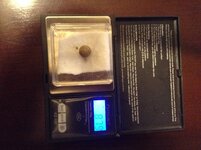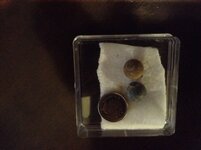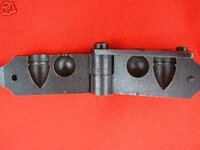Found near stoney creek on canada... possible to age?... battle of 1812 was fought within kilometers...weight in grams..
Navigation
Install the app
How to install the app on iOS
Follow along with the video below to see how to install our site as a web app on your home screen.
Note: This feature may not be available in some browsers.
More options
You are using an out of date browser. It may not display this or other websites correctly.
You should upgrade or use an alternative browser.
You should upgrade or use an alternative browser.
Musket balls?
- Thread starter clutch33
- Start date
HAPPYCAMPER
Hero Member
- Aug 18, 2012
- 530
- 426
- Detector(s) used
- MXT 300MM PISTOL PROBE FISKARS SPADE AND SHOVEL 12INCH,4X6 AND 8X6 SEF
XT600 TO GET THERE
BEST FIND TO DATE 1787 FUGIO
- Primary Interest:
- All Treasure Hunting
Just a guess but believe if musket ball they are newer than dug ones i see here in mid MA from old cellar holes we do...those look perfectly made and molded
Upvote
0
G.A.P.metal
Gold Member
- Jul 5, 2010
- 6,468
- 7,387
- 🥇 Banner finds
- 1
- Detector(s) used
- Deus, 11" Low Freq. , 9" X35 Coils, MI 6 Pointer...
Land or Sea Pointer
King Of Spades 40" KS-D SA and 40" KS-S-SA
L
- Primary Interest:
- Relic Hunting
clutch
An older lead ball,that has been in the ground years will have Lead Oxide on it.. a white patina ...the older the more pronounced.
Gary
An older lead ball,that has been in the ground years will have Lead Oxide on it.. a white patina ...the older the more pronounced.
Gary
Last edited:
Upvote
0
FreeBirdTim
Silver Member
- Sep 24, 2013
- 3,853
- 6,968
- 🥇 Banner finds
- 1
- Detector(s) used
- Garrett AT Pro
- Primary Interest:
- All Treasure Hunting
An older lead ball,that has been in the ground years will have Lead Oxide on it.. a white patina ...the older the more pronounced.
Not always true. All the musket balls I find here in RI are brown, due to the abundance of evergreens around here. The soil is black and rich, which gives them their dark color.
Here's my collection of musket balls. All were dug from spots that had buttons and coins from the 1700's and early 1800's:

Upvote
0
- Thread starter
- #5
Not always true. All the musket balls I find here in RI are brown, due to the abundance of evergreens around here. The soil is black and rich, which gives them their dark color.
Here's my collection of musket balls. All were dug from spots that had buttons and coins from the 1700's and early 1800's:
View attachment 1087273
I also found an 1842 bank of montreal half penny bank token in area
Upvote
0
HAPPYCAMPER
Hero Member
- Aug 18, 2012
- 530
- 426
- Detector(s) used
- MXT 300MM PISTOL PROBE FISKARS SPADE AND SHOVEL 12INCH,4X6 AND 8X6 SEF
XT600 TO GET THERE
BEST FIND TO DATE 1787 FUGIO
- Primary Interest:
- All Treasure Hunting
Wouldnt have guessed that...3 on left are very round.those are from your time frame?,will have to check all mine as cant remember getting one that uniform in shape.
Not always true. All the musket balls I find here in RI are brown, due to the abundance of evergreens around here. The soil is black and rich, which gives them their dark color.
Here's my collection of musket balls. All were dug from spots that had buttons and coins from the 1700's and early 1800's:
View attachment 1087273
Upvote
0
TheCannonballGuy
Gold Member
- Feb 24, 2006
- 6,596
- 13,391
- Detector(s) used
- White's 6000, Nautilus DMC-1, Minelab
- Primary Interest:
- Relic Hunting
Clutch33, the 8.79-grams weight of your lead ball translates to 135.6 grains, which means the ball is approximately .45-to-.46-inch in diameter, and that means it is for a .44-caliber "Cap-&-Ball" Revolver (such as a Colt) from the 1840s through 1860s.
Unlike balls (and bullets) for revolvers, which by definition are cylinder-loaded (the projectile enters at the rear of the gunbarrel), balls for muzzle-loading pistols and muskets were slightly smaller in diameter than the firearm's caliber. Your ball is a little bit too small to be for a .50-caliber muzzleloader.
Here's a photo showing an American civil war era Colt .44 Revolver's bulletmold, which cast a ball that looks exactly like yours, showing the small circular sliced-off moldcasting sprue.
Unlike balls (and bullets) for revolvers, which by definition are cylinder-loaded (the projectile enters at the rear of the gunbarrel), balls for muzzle-loading pistols and muskets were slightly smaller in diameter than the firearm's caliber. Your ball is a little bit too small to be for a .50-caliber muzzleloader.
Here's a photo showing an American civil war era Colt .44 Revolver's bulletmold, which cast a ball that looks exactly like yours, showing the small circular sliced-off moldcasting sprue.
Attachments
Last edited:
Upvote
0
gldnbrew
Full Member
- Feb 16, 2013
- 151
- 170
- Detector(s) used
- Garrett AT Pro and ATMax, 8.5 x 11, 5 x 8 & a Super Sniper - Pro-pointer.
Fisher F75 LTD, XP Deus - 11", Garrett AT and AT ZLINK pointer
- Primary Interest:
- Relic Hunting
clutch
An older lead ball,that has been in the ground years will have Lead Oxide on it.. a white patina ...the older the more pronounced.
Gary
Not necessarily so, I found a couple, from an 1813 battle, buried in mud with very, very little oxide on them. They were drops. I have over 70 musket balls from this battle, and yes the rest have the oxide on them, although some of them are stained rust colored or dark brown (similar to his other one) from the soil conditions.
Something appears to be amiss with the weight. If that says 8.79 grams, that is way too light for an 1812 musket ball. The Brown Bess ball should be in the neighborhood of 29 - 31 grams (68 - 74 cal. ball). The American Springfield should be in the neighborhood of approximately 20 grams (62 - 68 cal. ball). The Harper's 1803 (48 - 52 cal. ball) I haven't found one so I can't give you the approximate weight in grams. NOTE: these weights are based on my actual finds and not out of a book.
PS: In my collection I have never seen a sprue that pronounced on a musket ball.
Upvote
0
jan nielsen
Sr. Member
- Dec 3, 2014
- 267
- 250
- Detector(s) used
- Minelab 705
- Primary Interest:
- Metal Detecting
Nice.
Upvote
0
MuckyBottles
Bronze Member
Upvote
0
Top Member Reactions
-
 3357
3357 -
 1902
1902 -
 1860
1860 -
 1159
1159 -
 1088
1088 -
 880
880 -
 848
848 -
 847
847 -
 826
826 -
 767
767 -
 765
765 -
 546
546 -
 520
520 -
 499
499 -
 440
440 -
 427
427 -
E
418
-
 402
402 -
 398
398 -
 394
394
Users who are viewing this thread
Total: 2 (members: 0, guests: 2)












